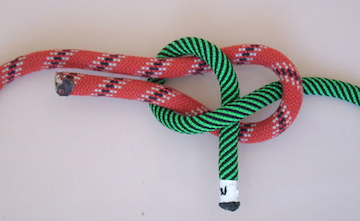The weaver’s knot (aka as the “sheetbend knot”) belongs to a category of knots known as a “bend.” Such bend knots are used to join one line with another.
There are many such bend knots. Perhaps the simplest, most well-known, and most-used even from ancient times, is the weaver’s knot. It is shown below:
For our metaphorical purposes here, the most-relevant aspect of the weaver’s knot is that it is used to create nets, such as shown below:
(both images are from www.wikipedia.com, and are published without copyright restrictions).
The essential point is this. The Bible is comprised of some 31,000 verses, each of which is in most instances a sentence. But these verses are not just some pile of statements that stand independently of one another, such as might occur in a book of quotations. In other words, the Bible would make not coherent sense if there was some mystical explosion at the print factory with the result that we each obtained a perfect pile of slips of paper each slip with a single verse on it, scattered about in some giant pile of 31,000 slips of paper. No, the Bible has a coherence, a knotted net, wherein these verses (like the individual weaver’s knots in the above images) connects with all the other knots, though in a much more sophisticated, interconnected way than shown by the net image (alas the limitations of a metaphor).
What we will seek to do here, is present examples of such interconnections. Such interconnectedness is what was essential for the Apostles, and in particular Paul, to grasp that Jesus Christ was the Jehovah / Yahweh of the Old Testament and so fulfilled every prophetic claim of his coming as Redeemer-Messiah.
There is an incredibly rich study in knotmaking the New Testament with the Old. Consider just the New Testament claim that Jesus Christ was the second Adam. However, unlike the first Adam, whereby the sin of one many led to the death of all men, the death of the second Adam (Jesus) has lead to the (restored) life of the many.
Consider, then, this passage from Romans 5 (New English Translation, NET). To make clear this example of ‘knots’ making a ‘net’ (i.e. a connection, a whole), the below text has bold font with bracketed clarifying references to the man Adam contrasted with the Lord Jesus Christ, to contrast two unique individuals, each with a work, each work causing a lasting consequence. Christ is clearly portrayed here as the second, and uniquely final, Adam, and Christ’s work restoring the ruin resulting from the fall of the first Adam, connecting for us the very beginning of Genesis with the coming of Jesus Christ.
5:12 So then, just as sin entered the world through one man and death through sin, and so death spread to all people because all sinned— 13 for before the law was given, sin was in the world, but there is no accounting for sin when there is no law. 14 Yet death reigned from Adam until Moses even over those who did not sin in the same way that Adam (who is a type of the coming one) transgressed. 15 But the gracious gift is not like the transgression. For if the many died through the transgression of the one man [i.e. Adam], how much more did the grace of God and the gift by the grace of the one man Jesus Christ multiply to the many! 16 And the gift is not like the one who sinned [i.e. Adam]. For judgment, resulting from the one transgression [Adam’s], led to condemnation, but the gracious gift [Christ’s] from the many failures led to justification. 17 For if, by the transgression of the one man [Adam], death reigned through the one [Adam], how much more will those who receive the abundance of grace and of the gift of righteousness reign in life through the one, Jesus Christ!
18 Consequently, just as condemnation for all people came through one transgression [Adam’s], so too through the one righteous act [Christ’s] came righteousness leading to life for all people. 19 For just as through the disobedience of the one man [Adam] many were made sinners, so also through the obedience of one man [Christ] many will be made righteous. 20 Now the law came in so that the transgression may increase, but where sin increased, grace multiplied all the more, 21 so that just as sin reigned in death, so also grace will reign through righteousness to eternal life through Jesus Christ our Lord.

